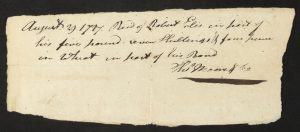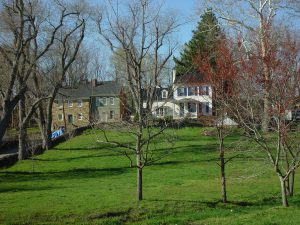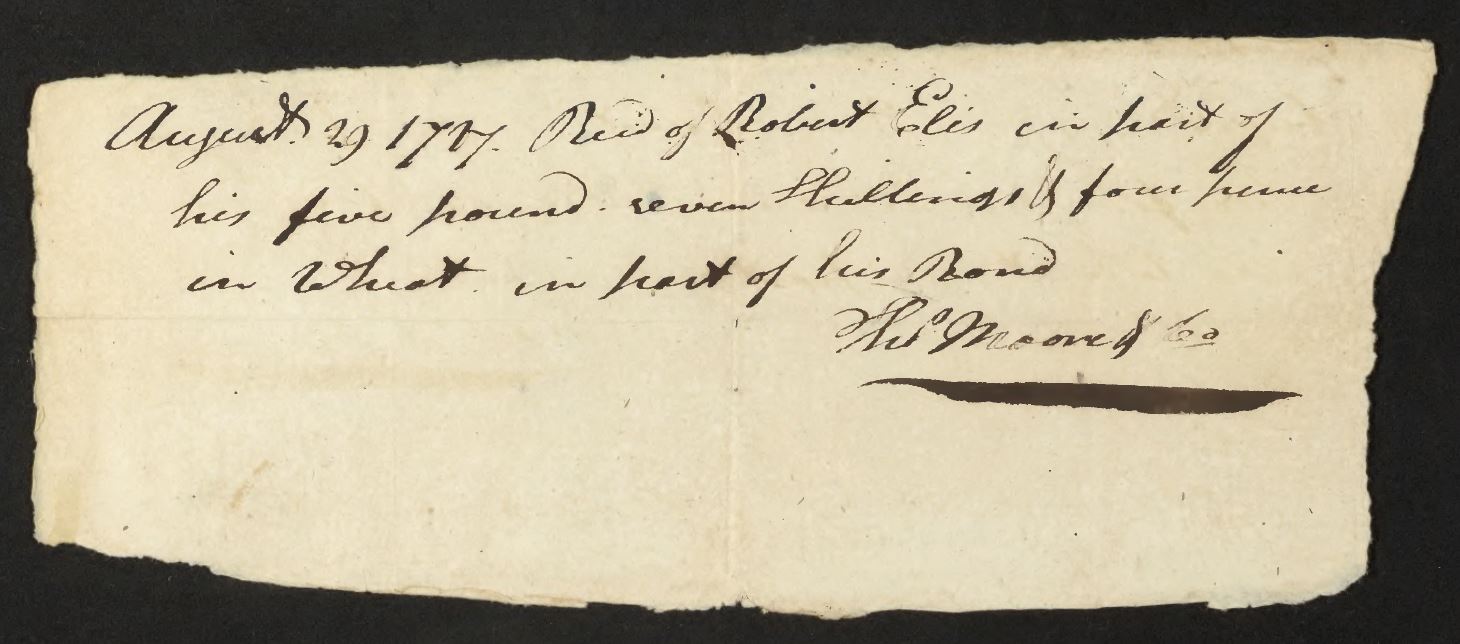By Debbie Robison, May 27, 2022
When the village of Waterford was founded at the close of the American Revolutionary War, a mercantile store and a number of manufacturing ventures were established that had a significant impact on the success of the village. Almost immediately, a remarkable variety of goods began to be manufactured, including tanned leather, saddles, and cabinets. Credit for developing these key businesses goes to one industrious Quaker family. Thomas Moore and his three adult sons, James Moore, Thomas Moore Jr, and Asa Moore, began several businesses on lots they bought and leased near Mahlon Janney’s mill. They likely named this new village after their homeland where the elder Thomas Moore was born.[1]

Thomas Moore Jr. opened a store, operated as Thomas Moore & Co, with financial assistance from Alexandria merchant John Sutton.[2] The success of the business was hindered by a post-war depression that began the year the store opened. While it was typical at that time to sell merchandise on credit, the store had to discontinue the practice during the depression and limit providing credit to the purchase of small trifles. During this time, when a new nation was being formed, the United States did not yet have a federal banking system. Virginia had its own currency, a holdover from the colonial period, in denominations of pound, shilling, and pence. On at least one occasion, the company accepted wheat, the predominant cash crop of the time, to pay down debts owed to the store.[3] The store closed about 1790 when Thomas Moore Jr. moved to Maryland.
The tannery, where animal hides were tanned to make them pliable, was established ca. 1785 on a small branch that became known as Tan Yard Run. James Moore leased the 3/4-acre lot from Joseph Janney, who developed the village.[4] Pits were dug in the ground for soaking the animal hides; first to remove the hair and fat from the hide, then to soften the hide into leather. Tanners often sold the hair that was removed from the hides to a local plasterer. Original lime plaster walls in the village may contain animal hair from the tannery. Asa Moore and his son-in-law, Thomas Phillips, took over the business from James Moore. In 1832, following Asa Moore’s death, the tannery had 40 to 50 in-ground vats, a large bark house (to store bark used to tan hides), a currying house (where leather was treated), and a handling house.[5] The Waterford Foundation owns this historic tannery site.

Asa Moore operated the saddlery where saddles were manufactured using tanned leather.[6] Saddle making required skilled craftsmanship to assemble saddles using glues while stitching together the various components.
Thomas Moore (Sr. or Jr.) was involved in a woodworking trade. It is unknown what type of products were made, though the skills of cabinet makers and joiners were used.[7] They could have been making furniture or had a role in building houses. A cabinet maker constructed furniture, such as cupboards, drawers, doors, and coffins. Joints, such as dovetail joints, were constructed by joiners to connect pieces of wood together.
The significance of the Moore family businesses is due, in part, to the many apprentices who were taught skills as boys while working for the Moores. At least 21 boys were apprenticed to the Moore family to work in these trades. Upon completing their apprenticeships, a number of these young men, along with other men who worked for the Moore family, established businesses in Waterford. For example, Henry Burkett, who lived with Thomas Moore, Jr. from 1789 through 1791, leased two lots on the south side of Main Street in 1792.[8] Evidently, Burkett knew the cabinet making/joiner trade because in 1793 Daniel Lovett (previously apprenticed to Thomas Moore) was bound to him to learn the trade of joiner.[9] In 1794, Jesse James (previously apprenticed to Thomas Moore, Jr to learn the trade of cabinet maker) was living with Burkett in the village.[10] Apparently they were operating a cabinet making shop. Another example is Joseph Talbott who, before becoming a tavern keeper, operated a saddle making business on Main Street.[11] He had previously lived with Asa Moore, who ran the Moore’s saddlery business, from 1792-1795.[12]
So not only was the Moore family vitally important at the formation of the village of Waterford, but they were also influential in its expansion and growth.
References
[1] Souders, Bronwyn C., Waterford, Virginia: Named for Waterford, Ireland, or not? (A Moore family history) [manuscript].
[2] Trust agreement between Thomas Moore Jr. and John Sutton, Loudoun County Deed Book O:423, 17 Jun 1785.
[3] George Emery etc. v. John Sutton, etc., Loudoun County Chancery Case 1791_009, pp. 12 and 15, as viewed at https://www.lva.virginia.gov/chancery/.
[4] Joseph Janney’s Will, Loudoun County Will Book D:341, probated October 11, 1793; Loudoun County Land Tax Ledgers: Alterations 1786, 1787-1799.
[5] “Public Sale,” Genius of Liberty, March 3, 1832, as viewed at www.geneologybank.com. Ad describes the tannery business of Moore & Phillips that was for sale.
[6] Loudoun County Order Book I:87, September 12, 1785.
[7] Loudoun County Order Book I:336
[8] Lease from Joseph Janney to Henry Burkett, Lots 7 and 8, Loudoun County Deed Book U:266, June 1, 1792.
[9] Loudoun County Order Book P:321.
[10] Loudoun County Personal Property Tax Ledgers, 1794-1796.
[11] Talbott, Joseph, Alexandria Daily Gazette, 11 Nov 1808.
[12] Loudoun County Personal Property Tax Ledgers, 1792-1795.

